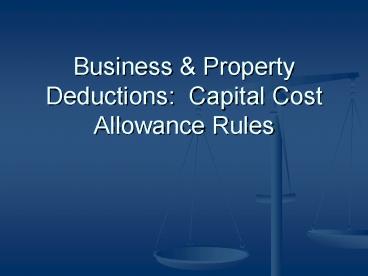Business
1 / 18
Title: Business
1
Business Property Deductions Capital Cost
Allowance Rules
2
Capital Cost Allowance
- S. 18(1)(b) Denies deduction for Capital
Expenditures except as permitted by the Act - S.20(1)(a) Allows Capital Cost Deductions (CCA)
- Depreciable Property
3
Straight Line Depreciation
Purchase a capital asset (building) at a cost of
10,000 and conventional principles of accounting
determine that asset falls in value at a rate of
10year
Year 1 Deduction of 10 of 10,000 1,000 Year
2 Deduction of 10 of 10,000 1,000 Year
3 Deduction of 10 of 10,000 1,000 Year
4 Deduction of 10 of 10,000 1,000 . Year
10 Deduction of 10 of 10,000 1,000
After 10 years, entire cost of the asset deducted
10 x 1,000 10,000
4
Declining Balance Method
Purchase a 10,000 asset for the business that
conventional accounting principles determine
depreciates 10 each year
Year 1 Deduction of 10 of 10,000 1,000 Year
2 Deduction of 10 of 9,000 900 (10,000 -
1,000 9,000) Year 3 Deduction of 10 of
8,100 810 (9,000 - 900 8,100) ..........
Declining balance means each year take a
deduction on the declining balance
5
Tax System
- Uses the Declining Balance Method of Accounting
- The Schedules to the Income Tax Act determine the
Rate of Depreciation to be taken on each class of
capital assets (ie 10, 8)
6
Capital Cost Allowance ITA s.20(1)(a)
- Depreciation Capital Cost Allowance (CCA)
- Undepreciated Capital Cost (UCC)
- Residual Value of Capital Assets that remains
after capital cost allowance - Equal to the Original Cost of the Capital MINUS
all the depreciation (deductions) taken in the
previous years - Defined in s. 13(21) as (AB)-(EF) where A is
the original cost, B is previous recapture, E is
CCA previously claimed and F is the lesser of
original cost or proceeds of disposition
7
Mechanics of CCA
- A. Determine Rate of Depreciation
- ITA Regulation 1100(1) sets out rates of
depreciation for all classes of property - Schedule II contains the details of each class
of property - Ie Buildings, class 3, CCA rate of 5
- B. Determine Allowable Capital Cost Deduction
8
Half-year rule Reg 1100(2)
- The rule deems assets in the year of acquisition
to be used for 6 months - Notional UCC UCC-½(acquisns-disposns in year)
- Notional UCC 100,000 - ½(100,000 0)
- 50,000
9
A buys a 100,000 building (capital) to use in
his/her business
Year 1 Cost of the Asset 100,000 CCA
Deduction (5 of 50,000) -
2,500 Residual Value of Asset (100,000 -
2,500) 97,500 UCC
Year 2 UCC (Value Left in the Building) 97,500
CCA Deduction (5 of 97,500) 4,875 Residual
Value of the Asset 92,625 UCC
10
Recapture, Terminal Loss and Capital Gains
Suppose in Year 3 each of the following
possibilities a. The building is sold for
95,000 b. The building is sold for 90,000 c.
The building is sold for 110,00
11
Possibility A Sell building for 95,000
- UCC of the building is 92,625. Pursuant to the
CCA system, the asset is worth this amount - Sale price is more than the assets value,
95,000 - Too much depreciation taken building is worth
95,000, not 92,625 - The difference, the amount of overdepreciation,
must be recapture 95,000 - 92,625 2,375
RECAPTURE - s. 13(1) - Recapture must be put back into
business income
12
Possibility B Selling the Building for 90,000
- UCC 92,625
- Sell for 90,000
- Value of the asset (price) is 90,000, not
90,250 - CCA system underdepreciated the asset
- Difference between 90,000 and 92,625 is a
Terminal Loss 2,625 - S.20(16) Terminal Loss must be deducted from
business income
13
Possibility C Sell building for 110,000
- UCC 92,625
- Sell for 110,000
- Asset did not depreciate at all must be a
recapture How much? - Recall original cost of the asset 100,000
- Need to account for both lack of depreciation
for the increase in value Recapture Capital
Gain
14
Possibility 3 Sell for 110,000
UCC 92,625 Subtract Lesser of Sale
price 110,000 Original cost 100,000 UCC -
7,375
AMOUNT OF OVER DEPRECIATION PREVIOUSLY DEDUCTED
FROM INCOME This amount is recaptured, added back
into business income
15
Possibility 3 Sell building for 110,000
UCC 92,625 Subtract Lesser of Sale
price 110,000 Original cost 100,000 UCC -
7,375
What about the remaining 10,000, the increase in
value over the original cost of the capital
asset? Purchased Building 100,000 Sold for
110,000 10,000
Recapture 7,375
CAPITAL GAIN
16
The Class Method of Depreciation
Start a business in 2000 and purchase one
boiler,100,000, for use in the business. In
2001, purchase a second boiler for 50,000
Year 2000 Class 3 Assets Rate 5 (Reg. 1100(1)
Schedule II) Cost of Asset 100,000 CCA
deduction 2,500 (5 of 50,000) UCC year
end 97,500
Year 2001, Class 3 Assets Opening UCC
97,500 Add purchases 50,000 New UCC
147,500 Take CCA (5 of 122,500) 6,125 UCC
year end 141,375
17
The Class Method of Depreciation
What happens if in 2002 the first boiler is sold
for 45,000?
Year 2002 Opening UCC 141,375 Subtract Lesser
of Proceeds of Sale (45,000) 45,000
Original Cost of Property(100,000) New
UCC 96,375
All acquisitions of assets must be added to the
UCC and all disposals (sales) must be subtracted
simply keeping track of Capital
18
Other considerations
- Bens (1955, Ex. Ct)
- s. 13(26)
- Apportionment between land and building
- s. 68
- s. 13(21.1)































